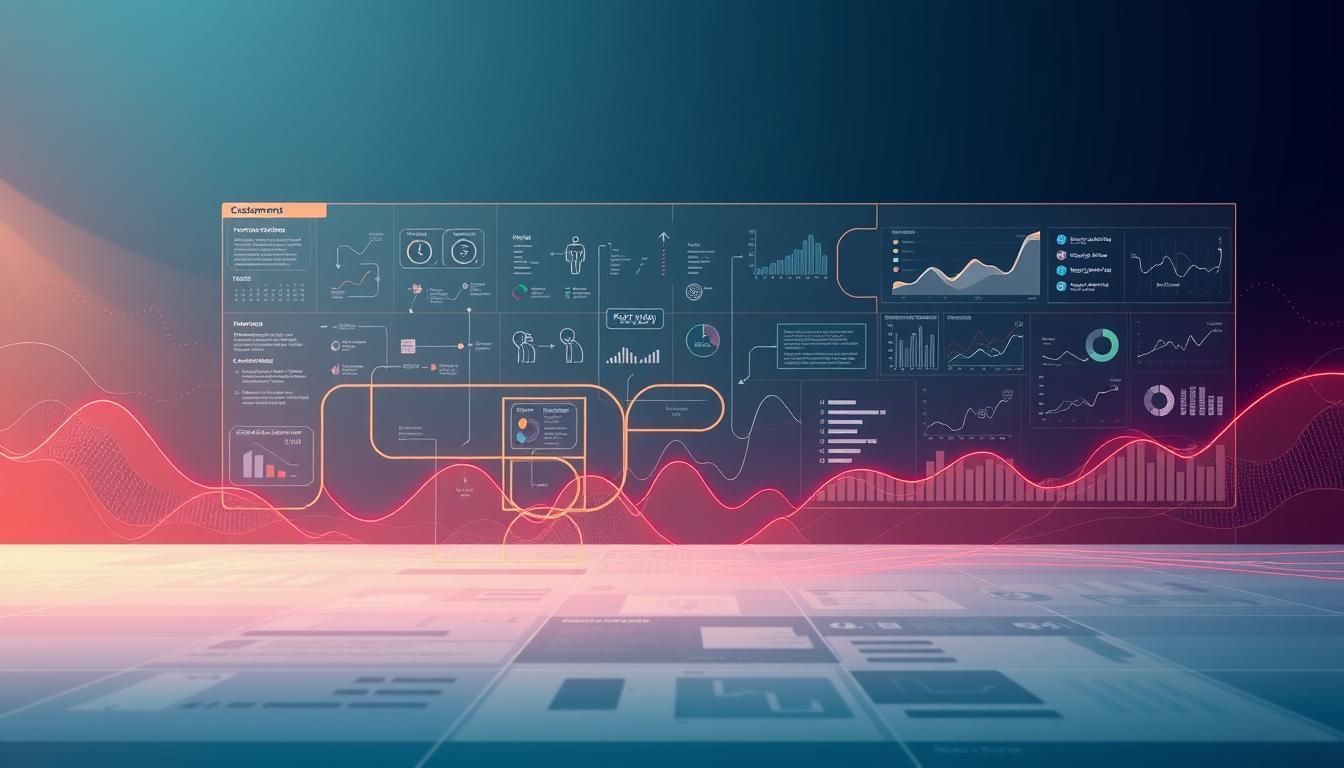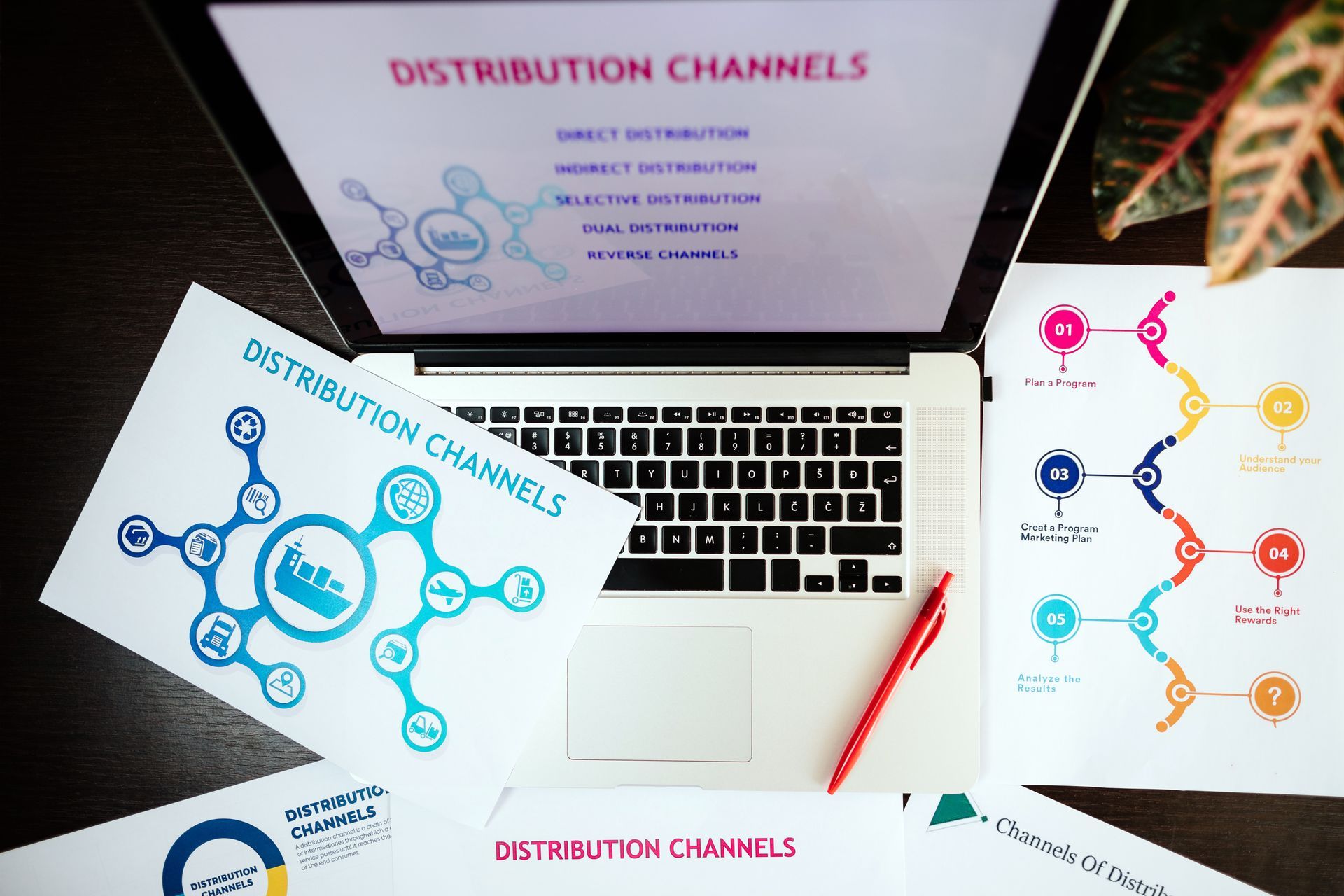Customer Segmentation That Converts: How to Use Data to Predict Buying Behavior

Did you know that businesses using data-driven marketing are six times more likely to make a profit? The secret to success is in knowing how to segment customers. By understanding what customers want, businesses can make their customer journey analysis better. This leads to happier customers and more sales.
At LayerFive, we give marketers the tools they need to succeed. Our marketing attribution modeling helps you guess what customers will buy. This way, you can make your marketing better and grow your business.
Key Takeaways
- Understand the importance of customer segmentation in data-driven marketing.
- Learn how to predict buying behavior using data insights.
- Discover how LayerFive's solutions can enhance your customer journey analysis.
- Improve conversions and ROI through targeted marketing strategies.
- Ensure privacy-compliant data practices for sustainable growth.
The Evolution of Customer Segmentation in Digital Marketing
The way we segment customers in digital marketing has changed a lot. We've moved from old methods to new, data-based ones. This change has helped businesses understand their customers better.
Traditional Segmentation Methods vs. Data-Driven Approaches
Old methods used basic demographic data and broad groups. Now, we use digital marketing analytics for detailed and changing customer segments. This lets businesses really get to know what their customers like and do.
The Impact of Big Data on Customer Insights
Big data has changed how we see customer insights. It lets businesses target and personalize better. With lots of data, they can spot patterns and trends they couldn't before.
Real-Time Segmentation Capabilities
Data-driven segmentation lets us segment customers as they interact. This is key for conversion tracking and making marketing campaigns better fast. Some benefits are:
- Better customer targeting
- Higher campaign ROI
- Quick campaign optimization
By using data-driven segmentation, businesses can stay competitive. They can also make their marketing more effective.
Understanding the Modern Customer Journey
For businesses, understanding the customer journey is key. Today's customers interact with brands in many ways. It's vital to analyze these interactions to guess what they might buy.
Multi-Channel Customer Interactions
Customers now reach out to brands through many channels. This includes social media, email, websites, and physical stores. Multi-channel customer interactions give a full picture of the customer's path, helping businesses spot trends and likes.
By studying these interactions, marketers can learn a lot. They can see:
- Which channels customers prefer
- How often they interact
- The devices they use to shop
Touchpoints That Matter Most in Purchase Decisions
Not every touchpoint affects buying decisions equally. Digital touchpoints like online reviews and social media ads are key. But offline touchpoints, like in-store visits, are also vital.
Digital vs. Offline Touchpoint Analysis
To truly get the customer journey, businesses must look at both digital and offline touchpoints. This means:
- Tracking online actions with analytics tools
- Gathering feedback from offline interactions through surveys and feedback forms
By mixing these insights, marketers can get a complete view of the customer journey. This helps them improve their strategies.
What is Marketing Attribution Modeling?
Marketers are always looking to improve their campaigns. That's where marketing attribution modeling comes in. It helps us see how our marketing efforts affect customers at different points and through various channels.
Definition and Core Concepts
Marketing attribution modeling is about giving credit to the marketing touchpoints that lead to a sale. We look at data from social media, email, and ads to see which ones matter most.
Understanding the customer's path, finding key touchpoints, and using data to guide our marketing are key. With attribution models, we can see how our marketing efforts are paying off.
Evolution of Attribution Models
Attribution models have changed a lot over time. They've moved from simple last-click models to more complex, data-driven ones. Now, we have many models, like single-touch and multi-touch, each showing a different part of the customer journey.
Key Questions Attribution Modeling Answers
So, what does attribution modeling help us figure out? It answers questions like: Which marketing channels bring in the most sales? How do different interactions affect customer behavior? And, how can we spend our marketing budget to get the best return?
By answering these, we can make smarter marketing choices. We can improve our campaigns and increase our business's revenue.
Types of Attribution Models and Their Applications
Understanding attribution models is key to unlocking the full power of marketing data. These models help businesses see how different marketing touchpoints lead to conversions. This way, they can make their marketing strategies better.
Single-Touch Attribution Models
Single-touch attribution models give all the credit for a conversion to one touchpoint. This makes attribution easier but might not show the whole customer journey.
First-Touch and Last-Touch Attribution
First-touch attribution credits the first touchpoint that introduces the customer to the brand. Last-touch attribution credits the last touchpoint before conversion. For example, a business might use first-touch attribution to see which marketing channels get initial interest. They might use last-touch attribution to see which channels drive conversions.
Multi-Touch Attribution Models
Multi-touch attribution models spread credit across multiple touchpoints. This gives a deeper look into the customer journey. These models are great for businesses with complex sales cycles.
Linear, Time-Decay, and U-Shaped Models
Linear attribution gives equal credit to all touchpoints. Time-decay attribution gives more credit to touchpoints near the conversion time. U-shaped attribution focuses on the first and last touchpoints, with less for in-between interactions. For example, a company might use U-shaped attribution to highlight the importance of both initial and final touchpoints.
Custom Attribution Models
Custom attribution models let businesses tailor attribution to their needs. By creating a custom model, companies can match their attribution to their unique customer journey and goals. For instance, a business might create a model that weighs certain touchpoints more based on historical data and customer behavior.
By knowing the different attribution models and their uses, marketers can pick the best one for their business. This leads to more effective marketing strategies and better conversion rates.
The Connection Between Attribution Data and Customer Behavior
Marketers need to understand how attribution data and customer behavior are linked. Attribution data shows how customers interact with our brand at different points. This helps us spot patterns and trends to shape our marketing plans.
Identifying Patterns in Customer Interactions
Looking at attribution data helps us see patterns in how customers act. For example, we might see that social media users are more likely to visit our website. This lets us spend our marketing budget where it matters most.
Correlating Touchpoints with Purchase Intent
It's key to link touchpoints with when customers are ready to buy. By studying the steps before a sale, we find out which marketing works best. Say, our email newsletter leads to more sales.
Behavioral Indicators of Buying Readiness
Some signs show when a customer is ready to buy. These include:
- Frequent visits to our website
- Engagement with our pricing page
- Downloads of our product catalog
By spotting these signs, we can adjust our marketing to help leads become customers. As we keep analyzing data, we can make our marketing better. This will help us grow our business.
Predictive Analytics: Turning Attribution Data into Behavioral Forecasts
Predictive analytics is changing the game for data-driven companies. It uses advanced models and machine learning to predict customer behavior with great accuracy. This helps businesses stay ahead and improve their marketing plans.
Machine Learning Algorithms for Behavior Prediction
Machine learning is key in predictive analytics. It helps marketers understand past data to guess future behavior. Algorithms like decision trees, random forests, and neural networks are used for this. They can handle lots of data, including attribution data, to predict what customers will do next.
"The use of machine learning in predictive analytics is not just a trend; it's a necessity for businesses aiming to stay competitive in a data-driven world," says an expert in the field.
Implementing Predictive Models in Marketing Campaigns
To use predictive models in marketing, several steps are needed. First, marketers must collect and integrate relevant data, like attribution data and customer info. Then, they need to select the right machine learning algorithm for their goals and data.
From Historical Data to Future Behavior Prediction
Turning past data into future predictions involves using attribution data to spot patterns. By looking at how customers have acted before, marketers can guess how they'll act in the future. This helps businesses personalize their marketing, leading to better customer engagement and sales.
- Identify key customer segments based on attribution data.
- Apply machine learning algorithms to predict future behavior.
- Optimize marketing campaigns based on predictive insights.
By using predictive analytics, marketers can turn their data into useful forecasts. This leads to more effective marketing and better business results.
Creating High-Value Customer Segments Using Attribution Data
We use attribution data to find and focus on high-value customer groups. This boosts our conversion rates and ROI. By looking at the customer journey and assigning value to each touchpoint, we craft marketing campaigns that speak to our audience.
Behavior-Based Segmentation Strategies
Behavior-based segmentation sorts customers by how they interact with our brand. This includes purchase history, browsing behavior, and engagement with marketing campaigns. Knowing these behaviors lets us make segments that meet specific marketing aims.
Channel Preference Segmentation
Channel preference segmentation looks at which communication channels customers prefer. This could be email, social media, or traditional advertising. By knowing what channels customers like, we can better reach our target audience.
Purchase Likelihood Segmentation
Purchase likelihood segmentation analyzes data to guess who will buy. This uses predictive analytics and machine learning algorithms. By finding out who's likely to buy, we can tailor marketing to them, raising conversion rates and ROI.
By using these segmentation strategies, we can make our marketing better. This drives business growth and boosts customer engagement. It's key to use attribution data well to create valuable customer segments that match our marketing goals.
Optimizing Campaigns with Marketing Attribution Insights
Marketing attribution insights help us make our campaigns better. Attribution modeling shows us how different parts of a campaign affect customers. This helps us make smart choices to improve our marketing.
Budget Allocation Based on Attribution Data
Marketing attribution modeling helps us spend our budget wisely. We learn which parts of our campaign work best. Then, we can focus more on those areas to get the best return on investment.
- Analyzing attribution data to identify high-performing channels
- Allocating more budget to channels that drive conversions
- Reducing spend on underperforming channels
Campaign Timing and Sequencing Optimization
Attribution insights also help us plan our campaigns better. We see how each part of the campaign works together. This helps us create a smoother experience for our customers.
- Identifying the optimal timing for campaign touchpoints
- Sequencing campaigns to maximize impact
- Using attribution data to inform campaign creative and messaging
Personalization Strategies for Different Segments
Personalizing our campaigns is important. Attribution insights help us understand what each customer likes. This way, we can make campaigns that really speak to them.
- Using attribution data to identify segment-specific preferences
- Creating personalized content and messaging for each segment
- Optimizing campaign delivery to reach the right audience at the right time
By using these strategies, we can maximize the impact of our marketing campaigns. Attribution insights are a powerful tool for making our campaigns better and engaging our customers more.
Measuring ROI Across Different Customer Segments
Getting accurate ROI across customer segments is vital for better marketing. Marketers must see how each segment adds to revenue. This helps us use our resources wisely and boost ROI.
Segment-Specific Performance Metrics
To measure ROI well, we need to find segment-specific performance metrics. These include conversion rates, average order value, and customer acquisition costs. Tracking these for each segment shows us which are most profitable and need more attention.
Calculating Customer Lifetime Value by Segment
Understanding Customer Lifetime Value (CLV) for each segment is also key. CLV shows the total value a customer brings over their lifetime. By segmenting CLV, we can focus on keeping and getting more high-value customers.
Attribution-Adjusted ROI Calculations
Calculating ROI needs adjusted attribution models. These models show how each marketing touchpoint affects the customer journey. Using attribution-adjusted ROI calculations makes our ROI measurements fair and accurate.
In summary, measuring ROI across customer segments is complex. It involves tracking specific metrics, calculating CLV, and adjusting attribution models. Mastering these steps can greatly enhance marketing performance and drive growth.
LayerFive's Approach to Attribution-Based Segmentation
LayerFive helps marketers understand customer behavior with data-driven insights. Knowing how customers act is key to better marketing. Our tools give a full view of the customer journey, helping businesses make smart choices.
Key Features of LayerFive's Attribution Solution
Our attribution solution has standout features:
- Advanced Data Collection: We gather data from many touchpoints for a complete customer view.
- AI-Driven Insights: Our AI finds patterns and predicts what customers might do next.
- Customizable Models: Marketers can adjust our models to fit their needs.
Integration with Existing Marketing Technology Stacks
We know businesses use many marketing tools. Our solution fits right in with these systems. This makes sure our tools work well with what you already have.
This integration lets for real-time data exchange. This means you get accurate and timely insights.
Real-Time Decision Making Capabilities
With LayerFive, marketers can make quick decisions. Our platform gives up-to-the-minute insights. This lets businesses act fast to changes in customer behavior.
This speed is vital in today's fast marketing world. Being agile and quick is key to success.
Using LayerFive's tools, businesses can fine-tune their marketing. This leads to better customer engagement and growth through smart data use.
Implementing Cross-Channel Attribution for Better Segmentation
Marketers can get a full view of how customers interact with them by using cross-channel attribution. This helps in better targeting and segmentation. It's key in today's world where people move easily between online and offline spaces.
Data Collection and Integration Strategies
Good cross-channel attribution starts with strong data collection and integration strategies. Marketers need to gather data from many places like social media, email, and offline. Then, they put all this data into one place, making it easy to see how customers interact.
Tools like Customer Data Platforms (CDPs) and Marketing Automation Platforms (MAPs) help a lot. They make it easier to collect, combine, and analyze customer data from different channels.
Privacy Considerations in Attribution Tracking
When using cross-channel attribution, marketers must think about privacy. They need to follow rules like GDPR and CCPA. This means getting the right consent for data use and keeping customer data safe.
It's important to use privacy-first attribution models. These models help marketers understand customer actions without invading their privacy. Using data in a way that protects privacy is key.
Technical Implementation Steps
Setting up cross-channel attribution involves a few main steps:
- Setting up tracking across all important channels
- Combining data from different sources into one place
- Using advanced analytics and machine learning on the data
- Keeping an eye on and improving the models with new data
By taking these steps and using the right tools, marketers can do cross-channel attribution well. This leads to better customer segmentation and marketing results.
Case Studies: Successful Attribution-Based Segmentation
Businesses can learn a lot from attribution-based segmentation. It helps them understand their customers better. This leads to better marketing strategies. Here are two examples that show how effective it can be.
E-commerce Brand Success Story
An e-commerce brand for outdoor gear used attribution-based segmentation. They looked at how customers interacted with them at different points. This helped them see what customers liked most.
Thanks to this, the brand's sales went up by 25% in six months. Here's how they did it:
- They combined data from different marketing channels.
- They used machine learning to understand customer behavior.
- They spent their marketing budget wisely based on what they learned.
The brand's marketing director said, "The insights from attribution-based segmentation were key to improving our marketing."
B2B Company Attribution Implementation
A B2B software company also used attribution-based segmentation. They focused on the quality of leads and how much customers were worth over time. This helped them target better and measure their return on investment.
Lead Quality Improvement Results
The B2B company saw a 40% better lead quality after using attribution-based segmentation. They noticed:
- They could spot valuable customer groups more easily.
- Marketing and sales teams worked better together.
- They used their marketing budget more wisely.
"Attribution-based segmentation changed how we do data-driven marketing. It helps us make better choices and grow steadily."
Marketing VP, B2B Software Company
These examples show how attribution-based segmentation can really help. It improves marketing, understanding customers, and measuring return on investment.
Common Challenges in Attribution-Based Segmentation
Attribution-based segmentation is powerful but faces challenges like data integration and getting everyone on board. Marketers often find it hard to make it work well.
Data Quality and Integration Issues
Ensuring good data quality and integration is a big challenge. Inaccurate or incomplete data can mess up attribution models. This can harm marketing decisions.
- Inconsistent data formats across different marketing channels
- Difficulty in integrating data from various sources
- Data quality issues due to technical glitches or human error
Organizational Alignment and Buy-In
Getting everyone on the same page is key for attribution-based segmentation. It means all departments must share the same goals. Everyone needs to understand how attribution models work.
- Lack of understanding of attribution models among team members
- Resistance to change from traditional marketing practices
- Need for cross-functional collaboration
Technical Implementation Hurdles
Setting up attribution-based segmentation comes with technical challenges. Finding the right digital marketing analytics tools and tracking conversions smoothly is essential.
- Choosing the appropriate attribution model for your business needs
- Technical difficulties in integrating attribution models with existing systems
- Ensuring data privacy and compliance with regulations
Marketers can tackle these challenges by understanding them. This way, they can make smart decisions to improve their marketing strategies.
Future Trends in Marketing Attribution and Customer Segmentation
The future of marketing attribution modeling looks bright. Advances in AI, machine learning, and privacy-first methods are leading the charge. As we tackle the complexities of customer behavior, our tools and strategies will evolve to meet new challenges and opportunities.
AI and Machine Learning Advancements
AI and machine learning are changing attribution modeling tools for the better. They allow for deeper analysis of customer interactions. This means marketers can spot patterns they couldn't before, leading to more accurate attribution and smarter decisions.
Privacy-First Attribution in a Cookieless World
Privacy concerns are on the rise, pushing the industry towards privacy-first attribution. New strategies are being developed that don't use cookies or other tracking methods. This ensures compliance with regulations while giving valuable insights.
Predictive Attribution Models
Predictive attribution models are key in data-driven marketing. They use historical data and machine learning to predict future customer actions. This lets marketers adjust their strategies proactively.
By adopting these trends, businesses can stay ahead and drive growth with more effective marketing.
Conclusion: Transforming Marketing Performance Through Data-Driven Segmentation
Marketers can boost conversions and ROI by using data-driven segmentation. Understanding the modern customer journey is key to predicting what they will buy. This knowledge helps in making better marketing plans.
We've looked at how customer segmentation, marketing attribution, and predictive analytics have evolved. These tools help marketers find and focus on the most valuable customers. They also improve campaign results and track ROI for different groups.
LayerFive's solution helps marketers make choices based on data, leading to business growth. It's important to keep up with new tech in data marketing. This includes AI and machine learning to guess what customers will do next.
Using data wisely can change how well marketing works. It can lead to more sales and growth. We suggest marketers look into data-driven methods for lasting success.
FAQ
What is marketing attribution modeling, and how does it help in customer segmentation?
Marketing attribution modeling helps figure out how different marketing actions affect customers. It finds the most valuable customer groups. It also shows what they like and need.
How does LayerFive's attribution modeling solution work?
LayerFive's solution uses smart algorithms and machine learning. It looks at how customers interact with different marketing points. This gives a full view of the customer journey and helps make better decisions.
What are the different types of attribution models, and which one is best for my business?
There are many attribution models, like single-touch and multi-touch. The right one for you depends on your marketing goals and customer behavior. Our experts can help pick the best one for your business.
How can I measure the ROI of my marketing campaigns using attribution data?
Attribution data lets you see how much revenue each marketing touchpoint brings in. This helps you spend your marketing budget better. It also makes your campaigns more effective.
What are the common challenges in implementing attribution-based segmentation, and how can I overcome them?
Challenges include bad data, getting everyone on board, and technical issues. Knowing your marketing goals well and having a solid plan helps. The right technology and expertise are also key.
How can I ensure data privacy and compliance when implementing attribution modeling?
Make sure your attribution modeling solution follows rules like GDPR and CCPA. LayerFive's solution is designed with privacy and compliance in mind. This keeps your customer data safe and secure.
Can I integrate LayerFive's attribution modeling solution with my existing marketing technology stack?
Yes, LayerFive's solution works with your current marketing tools. This makes data sharing smooth and boosts your marketing data's value.
You might also like:




